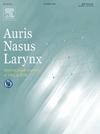双表型鼻窦肉瘤:碳离子放射治疗2例报告
IF 1.5
4区 医学
Q2 OTORHINOLARYNGOLOGY
引用次数: 0
摘要
摘要双表型鼻窦肉瘤(BSNS)是一种罕见的肿瘤,其特征是肌系和神经系的双重分化。在此,我们描述了两例BSNS用碳离子放射治疗。第一个病例涉及一名83岁的妇女,她的肿瘤填充了左鼻腔。影像学检查显示肿块占据左鼻腔和筛窦,但未发现颈部淋巴结或远处转移。免疫组化染色显示α - sma(平滑肌肌动蛋白)和S-100阳性,而SOX-10阴性,提示BSNS。此外,还鉴定了一个PAX3-MAML3融合基因。第二个病例涉及一名74岁男性,因右鼻前庭肿瘤而出现右颊肿胀。影像学检查显示右侧鼻前庭肿块延伸至上颌窦。免疫组化结果显示α - sma和S-100阳性,而SOX-10阴性,诊断为BSNS。然而,本病例中未检测到三种PAX3融合基因。两例患者均行碳离子放疗,治疗效果良好。碳离子放射治疗可能是BSNS患者的潜在治疗选择。本文章由计算机程序翻译,如有差异,请以英文原文为准。
Biphenotypic sinonasal sarcoma: Report of two cases treated with carbon-ion radiotherapy
Biphenotypic sinonasal sarcoma (BSNS) is a rare tumor characterized by dual differentiation into muscular and neural lineages. Herein, we describe two cases of BSNS treated with carbon-ion radiotherapy. The first case involves an 83-year-old woman who presented with a tumor filling the left nasal cavity. Imaging studies showed a mass occupying the left nasal cavity and ethmoidal sinus, but no cervical lymph node or distant metastases were identified. Immunohistochemical staining revealed positivity for αSMA (smooth muscle actin) and S-100, while SOX-10 was negative, suggesting a diagnosis of BSNS. Additionally, a PAX3-MAML3 fusion gene was identified. The second case involves a 74-year-old man who presented with right buccal swelling due to a tumor in the right nasal vestibule. Imaging studies revealed a mass in the right nasal vestibule extending into the maxillary sinus. Immunohistochemistry showed positivity for αSMA and S-100 but negativity for SOX-10, confirming a diagnosis of BSNS. However, none of the three tested PAX3 fusion genes were detected in this case. Both patients were treated with carbon-ion radiotherapy, which demonstrated favorable therapeutic effects. Carbon-ion radiotherapy may be a potential therapeutic option for patients with BSNS.
求助全文
通过发布文献求助,成功后即可免费获取论文全文。
去求助
来源期刊

Auris Nasus Larynx
医学-耳鼻喉科学
CiteScore
3.40
自引率
5.90%
发文量
169
审稿时长
30 days
期刊介绍:
The international journal Auris Nasus Larynx provides the opportunity for rapid, carefully reviewed publications concerning the fundamental and clinical aspects of otorhinolaryngology and related fields. This includes otology, neurotology, bronchoesophagology, laryngology, rhinology, allergology, head and neck medicine and oncologic surgery, maxillofacial and plastic surgery, audiology, speech science.
Original papers, short communications and original case reports can be submitted. Reviews on recent developments are invited regularly and Letters to the Editor commenting on papers or any aspect of Auris Nasus Larynx are welcomed.
Founded in 1973 and previously published by the Society for Promotion of International Otorhinolaryngology, the journal is now the official English-language journal of the Oto-Rhino-Laryngological Society of Japan, Inc. The aim of its new international Editorial Board is to make Auris Nasus Larynx an international forum for high quality research and clinical sciences.
 求助内容:
求助内容: 应助结果提醒方式:
应助结果提醒方式:


